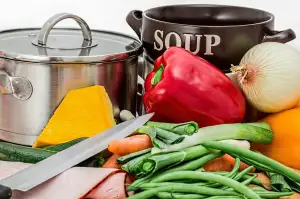Discover the Exquisite Flavors of Tagine Recipes: A Culinary Journey to Morocco

- History and Origin of Tagine Cooking
- Essential Ingredients for Tagine Recipes
- Traditional Tagine Recipes
- Lamb Tagine with Apricots and Almonds
- Chicken Tagine with Preserved Lemons and Olives
- Vegetable Tagine with Chickpeas and Couscous
- Modern Variations of Tagine Recipes
- Seafood Tagine with Spices and Herbs
- Beef Tagine with Prunes and Cinnamon
- Vegan Tagine with Root Vegetables and Quinoa
- Tips for Cooking with a Tagine
- Serving Suggestions and Accompaniments for Tagine Recipes
Tagine recipes are a delightful culinary journey that takes us to the vibrant and exotic land of Morocco. These flavorful dishes, cooked in a traditional clay pot called a tagine, have been enjoyed for centuries and continue to captivate food enthusiasts around the world. The unique combination of aromatic spices, tender meats, and fragrant vegetables creates a symphony of flavors that is truly unforgettable. Join us as we embark on this gastronomic adventure and discover the exquisite delights of tagine recipes.
History and Origin of Tagine Cooking
Tagine cooking has a rich history that dates back centuries in Morocco. The word "tagine" refers to both the unique clay pot used for cooking and the flavorful dishes prepared inside it. This traditional method of cooking originated with the Berber tribes of North Africa, who used tagines to slow-cook their meals over open fires.
The design of the tagine pot is essential to its cooking style. Its conical shape allows for even distribution of heat, while the tight-fitting lid helps retain moisture and flavors. This method of cooking creates tender and succulent dishes with intense flavors.
Originally, tagines were made with simple ingredients like meat, vegetables, and aromatic spices readily available in the region. As time passed, trade routes introduced new ingredients such as dried fruits and nuts, which added a unique sweetness to the savory dishes.
The slow-cooking process of tagine recipes allows the flavors to meld together beautifully, resulting in a dish that is both fragrant and full-bodied. Today, tagine cooking has evolved into an art form, with chefs experimenting with various combinations of ingredients and spices to create innovative and modern interpretations of this traditional cuisine.
Exploring the history and origin of tagine cooking not only provides insight into Moroccan culture but also showcases the versatility and depth of flavors that can be achieved through this ancient culinary technique.
Essential Ingredients for Tagine Recipes
Tagine recipes are known for their rich and aromatic flavors, which are achieved through the use of a variety of essential ingredients. These ingredients form the foundation of any traditional tagine dish and contribute to its unique taste. Some of the key ingredients include:
1. Spices: Tagine recipes often feature a blend of spices that add depth and complexity to the dish. Common spices used include cumin, coriander, ginger, turmeric, cinnamon, and saffron.
2. Meat: Traditionally, tagines are made with lamb or chicken as the main protein. The meat is usually slow-cooked in the tagine pot until it becomes tender and succulent.
3. Fruits: Dried fruits like apricots, dates, and prunes are commonly used in tagine recipes to add a touch of sweetness and balance out the savory flavors.
4. Vegetables: A variety of vegetables such as onions, carrots, tomatoes, bell peppers, and zucchini are often included in tagines to provide texture and enhance the overall flavor profile.
5. Preserved Ingredients: Preserved lemons and olives are staple ingredients in Moroccan cuisine and are frequently used in tagine recipes to impart a tangy and briny taste.
6. Nuts: Almonds, pistachios, or pine nuts are often added to tagines for an added crunch and nutty flavor.
By using these essential ingredients in combination with various cooking techniques such as slow simmering or braising, you can create a truly authentic and delicious tagine dish that captures the essence of Moroccan cuisine.
Traditional Tagine Recipes
Traditional Tagine Recipes are the heart and soul of Moroccan cuisine. These dishes have been passed down through generations, preserving the rich flavors and aromas that make them so special. Here are three classic tagine recipes that will transport you to the vibrant streets of Morocco.
First up is Lamb Tagine with Apricots and Almonds. This dish combines tender pieces of lamb with sweet dried apricots and crunchy almonds. The meat is slow-cooked in a fragrant blend of spices like cumin, coriander, and cinnamon, resulting in a melt-in-your-mouth texture and a delightful balance of flavors.
Next is Chicken Tagine with Preserved Lemons and Olives. This recipe features succulent chicken thighs cooked in a tangy sauce made from preserved lemons, olives, garlic, and aromatic spices like turmeric and ginger. The combination of savory and citrusy flavors creates a truly memorable dish.
For those who prefer vegetarian options, Vegetable Tagine with Chickpeas and Couscous is a perfect choice. This hearty dish showcases an array of colorful vegetables such as carrots, zucchini, bell peppers, and eggplant, simmered in a flavorful broth along with protein-rich chickpeas. Served over fluffy couscous, it's a satisfying meal that will please even the most discerning palates.
These traditional tagine recipes capture the essence of Moroccan cuisine with their bold flavors and aromatic spices. Whether you're hosting a dinner party or simply want to explore new culinary horizons, these dishes are sure to impress your guests and transport them to the enchanting land of Morocco.
Lamb Tagine with Apricots and Almonds
One of the most beloved traditional tagine recipes is the Lamb Tagine with Apricots and Almonds. This dish combines tender pieces of lamb with the sweetness of dried apricots and the crunchiness of almonds, creating a harmonious blend of flavors.
To make this tagine, start by marinating the lamb in a mixture of spices such as cumin, coriander, ginger, and cinnamon. This allows the meat to absorb all the aromatic flavors. Then, in a hot tagine pot, sear the lamb until it develops a golden brown crust.
Next, add onions, garlic, and sauté them until they become translucent. The addition of these aromatics enhances the overall depth of flavor in the dish. To balance out the richness of the lamb, dried apricots are added for their natural sweetness. These apricots rehydrate during cooking and release their sweet juices into the sauce.
To further enhance the texture and taste profile, toasted almonds are sprinkled on top before covering the tagine pot and allowing it to simmer slowly over low heat. This slow cooking process ensures that all the flavors meld together beautifully.
The result is a succulent lamb tagine with tender meat that falls off the bone, complemented by bursts of sweetness from the apricots and a delightful crunch from the almonds. The combination of spices adds warmth and depth to this classic Moroccan dish.
Serve this Lamb Tagine with Apricots and Almonds over fluffy couscous or alongside some warm crusty bread to soak up all those delicious juices. It's a perfect centerpiece for any special occasion or when you simply want to indulge in an exotic culinary experience.
Experience Morocco's rich culinary heritage through this exquisite Lamb Tagine with Apricots and Almonds recipe – it will transport your taste buds on an unforgettable journey!
Chicken Tagine with Preserved Lemons and Olives
Chicken Tagine with Preserved Lemons and Olives is a classic Moroccan dish that combines tender chicken with the tangy flavors of preserved lemons and briny olives. The chicken is slow-cooked in a traditional tagine pot, allowing the flavors to meld together beautifully. The preserved lemons add a unique citrusy taste, while the olives provide a salty kick. This dish is often seasoned with aromatic spices such as cumin, coriander, and paprika, giving it a rich and fragrant flavor profile. It is typically served with fluffy couscous or crusty bread to soak up the delicious sauce. This tagine recipe is a must-try for anyone looking to experience the authentic flavors of Moroccan cuisine.
Vegetable Tagine with Chickpeas and Couscous
Vegetable Tagine with Chickpeas and Couscous is a delightful vegetarian option that showcases the vibrant flavors of Morocco. This tagine recipe is packed with an assortment of colorful vegetables, including carrots, zucchini, bell peppers, and tomatoes. The addition of hearty chickpeas adds protein and texture to the dish.
To make this vegetable tagine, start by sautéing onions and garlic in olive oil until fragrant. Then add the vegetables and cook until they begin to soften. Next, add a blend of warm spices such as cumin, coriander, paprika, and turmeric to enhance the flavors.
For added depth of flavor, you can also include preserved lemons or dried apricots. These ingredients provide a tangy or sweet element that perfectly balances out the savory notes in the dish.
Once all the ingredients are combined in the tagine pot, cover it and let it simmer on low heat for about 30-40 minutes. This allows all the flavors to meld together beautifully.
To serve this vegetable tagine, prepare fluffy couscous separately according to package instructions. Spoon the tender vegetables and aromatic sauce over a bed of couscous for a complete meal that is both satisfying and nutritious.
The Vegetable Tagine with Chickpeas and Couscous is not only delicious but also versatile. You can customize it by adding your favorite vegetables or adjusting the spice levels according to your taste preferences.
This vegetarian tagine recipe offers a wonderful way to explore Moroccan cuisine while enjoying a healthy and flavorful meal. Whether you follow a vegetarian diet or simply want to incorporate more plant-based options into your meals, this vegetable tagine is sure to impress your taste buds with its rich flavors and enticing aromas.
Modern Variations of Tagine Recipes
In recent years, chefs and home cooks alike have been experimenting with new and exciting variations of traditional tagine recipes. These modern twists on the classic Moroccan dish offer a fresh take on the flavors and ingredients used in tagine cooking.
One popular modern variation is the Seafood Tagine with Spices and Herbs. This dish combines the delicate flavors of fresh seafood such as shrimp, fish, and mussels with aromatic spices like cumin, paprika, and saffron. Fresh herbs like cilantro and parsley add a burst of freshness to the dish.
Another delicious modern twist is the Beef Tagine with Prunes and Cinnamon. The combination of tender beef, sweet prunes, and warm cinnamon creates a rich and flavorful dish that is perfect for colder months. The slow-cooking process allows the flavors to meld together beautifully.
For those following a vegan or vegetarian diet, there's the Vegan Tagine with Root Vegetables and Quinoa. This hearty dish features an array of colorful root vegetables like carrots, parsnips, and sweet potatoes cooked in a flavorful broth with quinoa. It's a nutritious and satisfying option that showcases the versatility of tagine cooking.
These modern variations demonstrate how tagine recipes can be adapted to suit different tastes and dietary preferences while still capturing the essence of Moroccan cuisine. Whether you're a seafood lover, a meat enthusiast, or a plant-based eater, there's a tagine recipe out there for you to explore and enjoy.
Seafood Tagine with Spices and Herbs
Seafood Tagine with Spices and Herbs: One of the modern variations of tagine recipes is the delightful Seafood Tagine with Spices and Herbs. This dish combines the freshness of seafood with a medley of aromatic spices and herbs, creating a burst of flavors that will tantalize your taste buds. The tagine is filled with succulent prawns, tender fish fillets, and juicy mussels, all simmered in a fragrant broth infused with cumin, paprika, saffron, and fresh herbs like cilantro and parsley. The result is a rich and flavorful dish that showcases the best of Moroccan cuisine. Serve this seafood tagine with fluffy couscous or crusty bread to soak up all the delicious juices. It's a perfect choice for seafood lovers looking to explore the exotic flavors of Morocco.
Beef Tagine with Prunes and Cinnamon
Beef Tagine with Prunes and Cinnamon is a delightful variation of the traditional Moroccan dish. This recipe combines tender beef chunks with sweet prunes and warm cinnamon, creating a rich and aromatic flavor profile. The slow cooking process allows the flavors to meld together, resulting in a succulent and tender meat that practically melts in your mouth. The sweetness from the prunes balances perfectly with the earthy spices, making this tagine a true culinary masterpiece. Serve it over fluffy couscous or with crusty bread to soak up all the delicious sauce.
Vegan Tagine with Root Vegetables and Quinoa
For those who prefer a plant-based diet, the vegan tagine with root vegetables and quinoa is a delightful option. This recipe combines the earthy flavors of root vegetables with the nuttiness of quinoa, creating a wholesome and satisfying dish.
To make this vegan tagine, start by sautéing onions and garlic in olive oil until fragrant. Then, add a medley of root vegetables such as carrots, parsnips, and sweet potatoes. These vegetables not only provide a rich depth of flavor but also lend a vibrant color to the dish.
Next, sprinkle in Moroccan spices like cumin, coriander, and turmeric to infuse the tagine with aromatic notes. The combination of these spices adds warmth and complexity to the dish.
To enhance the texture and protein content of the tagine, incorporate cooked quinoa into the mix. Quinoa is not only gluten-free but also packed with essential nutrients like fiber and iron.
Allow all the ingredients to simmer together in vegetable broth until tender. The slow cooking process allows the flavors to meld beautifully while ensuring that each bite is bursting with taste.
Before serving, garnish the vegan tagine with fresh herbs such as parsley or cilantro for an added burst of freshness. The herbs bring a vibrant touch to the dish and complement its earthy flavors perfectly.
This vegan tagine can be enjoyed on its own or served alongside fluffy couscous or crusty bread for a complete meal. It's a perfect choice for those seeking a hearty yet healthy option that celebrates the natural goodness of plant-based ingredients.
In conclusion, exploring Moroccan cuisine through tagine recipes opens up a world of delightful flavors. Whether you choose traditional recipes or modern variations, each bite promises an exquisite culinary experience that transports you to Morocco's vibrant food culture. So gather your ingredients, dust off your tagine pot, and embark on a culinary journey to discover the magic of tagine recipes.
Tips for Cooking with a Tagine
1. Season the tagine: Before using your tagine for the first time, it is important to season it. This involves coating the inside of the tagine with olive oil and baking it in the oven at a low temperature for about an hour. This helps to create a non-stick surface and enhances the flavors of your dishes.
2. Use low heat: Tagines are designed to be cooked slowly over low heat, allowing the flavors to develop and intensify. It is important to resist the temptation to crank up the heat as this can lead to burning or toughening of ingredients.
3. Add liquid sparingly: Tagines are known for their rich and flavorful sauces, but it is important not to add too much liquid at once. The tagine's unique design allows for condensation to collect on the lid and drip back into the dish, keeping it moist. Start with a small amount of liquid and add more if needed during cooking.
4. Layer ingredients properly: To ensure even cooking and distribution of flavors, layer your ingredients properly in the tagine. Start with a base of onions or other aromatic vegetables, followed by meat or protein, and then add vegetables or fruits on top.
5. Resist lifting the lid: While it may be tempting to check on your dish frequently, try to resist lifting the lid too often during cooking. Each time you lift the lid, you release steam and heat, which can affect cooking times and result in unevenly cooked food.
6. Allow for resting time: Once your tagine is cooked, allow it to rest for a few minutes before serving. This allows the flavors to meld together and ensures that all ingredients are tender and fully cooked.
By following these tips, you can make the most out of your tagine cooking experience and create delicious Moroccan-inspired dishes that will transport you straight to Morocco's vibrant culinary scene.
Serving Suggestions and Accompaniments for Tagine Recipes
Tagine dishes are best enjoyed with traditional Moroccan accompaniments. Serve your tagine with a side of fluffy couscous, which will soak up the flavorful sauce. You can also serve it with fragrant saffron rice or warm crusty bread to mop up the delicious juices.
To add freshness and balance to your meal, serve a side salad of chopped tomatoes, cucumbers, and fresh herbs dressed with lemon juice and olive oil. The acidity of the salad complements the rich flavors of the tagine.
For a complete Moroccan experience, serve some preserved lemons on the side. These tangy condiments add a burst of flavor to each bite. Olives are another classic accompaniment that pairs well with both meat and vegetable tagines.
To enhance the dining experience, consider serving mint tea as a refreshing beverage. Its sweet aroma and soothing taste complement the bold flavors of the tagine dishes.
By pairing your tagine with these traditional accompaniments, you will create an authentic Moroccan feast that will transport your taste buds to the vibrant streets of Marrakech.
In conclusion, tagine recipes offer a delightful culinary journey to Morocco, where flavors and aromas come together in harmony. From traditional lamb and chicken tagines to modern variations with seafood, beef, and vegetables, there is a tagine recipe for every palate. The slow-cooking method in a tagine pot allows the ingredients to meld together, creating tender and flavorful dishes. Whether you are a meat lover or prefer vegan options, tagine cuisine offers something for everyone. So why not embark on this gastronomic adventure and discover the exquisite flavors of tagine recipes?
Published: 21. 11. 2023
Category: Recipes



